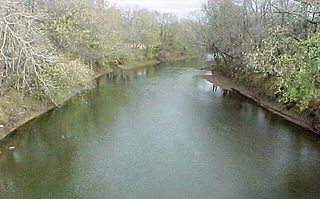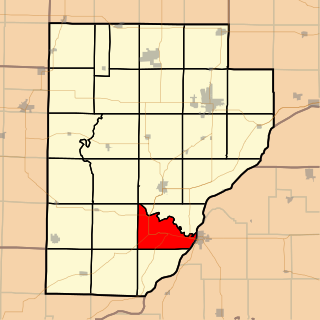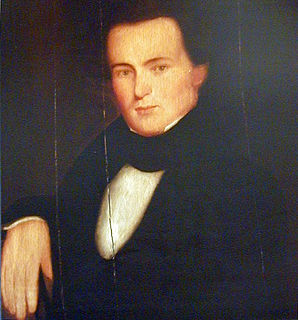
Fulton County is a county in the U.S. state of Illinois. According to the 2010 census, it had a population of 37,069. Its county seat is Lewistown, and the largest city is Canton. Fulton County comprises the Canton, IL Micropolitan Statistical Area, which is part of the Peoria-Canton, IL Combined Statistical Area.

Lewistown is a city in Fulton County, Illinois, United States. It was named by its founder, Ossian M. Ross, after his oldest son, Lewis W. Ross. The population was 2,384 at the 2010 census, down from 2,522 at the 2000 census. It is the county seat of Fulton County. Located in central Illinois, it is southwest of Peoria. It is the source of Spoon River Anthology by Edgar Lee Masters, who lived there. Native American burial mounds are nearby at Dickson Mounds off Illinois Route 97.

Macomb is a city in and the county seat of McDonough County, Illinois, United States. It is situated in western Illinois, southwest of Galesburg. The city is about 75 miles (121 km) southwest of Peoria and 77 miles (124 km) south of the Quad Cities. A special census held in 2014 placed the city's population at 21,516. Macomb is the home of Western Illinois University.

Edgar Lee Masters was an American attorney, poet, biographer, and dramatist. He is the author of Spoon River Anthology, The New Star Chamber and Other Essays, Songs and Satires, The Great Valley, The Serpent in the Wilderness, An Obscure Tale, The Spleen, Mark Twain: A Portrait, Lincoln: The Man, and Illinois Poems. In all, Masters published twelve plays, twenty-one books of poetry, six novels and six biographies, including those of Abraham Lincoln, Mark Twain, Vachel Lindsay, and Walt Whitman.

The Spoon River is a 147-mile-long (237 km) tributary of the Illinois River in west-central Illinois in the United States. The river drains largely agricultural prairie country between Peoria and Galesburg. The river is noted for giving its name to the fictional Illinois town in the 1916 poetry work Spoon River Anthology by Edgar Lee Masters, who was from Lewistown, which is near the river.

Spoon River Anthology (1915), by Edgar Lee Masters, is a collection of short free verse poems that collectively narrates the epitaphs of the residents of Spoon River, a fictional small town named after the Spoon River, which ran near Masters' home town of Lewistown, Illinois. The aim of the poems is to demystify rural and small town American life. The collection includes 212 separate characters, in all providing 244 accounts of their lives, losses, and manner of death. Many of the poems contain cross-references that create an unabashed tapestry of the community. The poems originally were published in 1914 in the St. Louis, Missouri, literary journal Reedy's Mirror, under the pseudonym Webster Ford.

Phi Alpha (ΦΑ) is a men's Literary Society founded in 1845 at Illinois College in Jacksonville, Illinois. It conducts business meetings, literary productions, and other activities in Beecher Hall, the oldest college building in the state of Illinois.

Forgottonia, also spelled Forgotonia, is the name given to a 16-county region in Western Illinois in the late 1960s and early 1970s. This geographic region forms the distinctive western bulge of Illinois that is roughly equivalent to "The Tract", the Illinois portion of the Military Tract of 1812, along and west of the Fourth Principal Meridian. Since this wedge-shaped region lies between the Illinois and Mississippi rivers, it has historically been isolated from the eastern portion of Central Illinois.
The Illinois Historic Preservation Division, formerly Illinois Historic Preservation Agency, is a governmental agency of the U.S. state of Illinois, and is a division of the Illinois Department of Natural Resources. It is tasked with the duty of maintaining State-owned historic sites, and maximizing their educational and recreational value to visitors or on-line users. In addition, it manages the process for applications within the state for additions to the National Register of Historic Places.

The Joseph F. Glidden House is located in the United States in the DeKalb County, Illinois city of DeKalb. It was the home to the famed inventor of barbed wire Joseph Glidden. The barn, still located on the property near several commercial buildings, is said to be where Glidden perfected his improved version of barbed wire which would eventually transform him into a successful entrepreneur. The Glidden House was added to the National Register of Historic Places in 1973. The home was designed by another barbed wire patent holder in DeKalb, Jacob Haish.

Isabel Township is one of twenty-six townships in Fulton County, Illinois, USA. At the 2010 census, its population was 192 and it contained 87 housing units.

Lewis Winans Ross was an Illinois attorney, merchant, and U.S. Representative from Illinois' 9th congressional district. He was widely known as an antiwar Peace Democrat or Copperhead during the American Civil War.

William Kellogg was a U. S. Representative from Illinois and Chief Justice of the Territorial Supreme Court of the Nebraska Territory.
Tuscumbia is a ghost town in Bernadotte Township, Fulton County, Illinois, US, that sprang up in the township and was platted by Wade Hampton on 2 March 1837. It consisted of 54 lots. It flourished for a while and had a school, but by 1855 was abandoned.

Maden Hall Farm, also called the Fermanagh-Ross Farm, is a historic farm near the U.S. city of Greeneville, Tennessee. Established in the 1820s, the farmstead consists of a farmhouse and six outbuildings situated on the remaining 17 acres (6.9 ha) of what was once a 300-acre (120 ha) antebellum farm. Maden Hall has been designated a century farm and has been placed on the National Register of Historic Places.

Ossian M. Ross was a pioneer farmer, stock-raiser, and merchant in Illinois, who served as a major in the War of 1812 and subsequently founded the Illinois towns of Lewistown and Havana, and who also played a prominent role in establishing Fulton and Mason counties in that state.

Oak Hill Cemetery is located in the city of Lewistown, Illinois. It lies along Illinois Route 97 and 100 in the 1000 block of North Main Street. The south part of the cemetery is on the National Register of Historic Places.

Isaac Newton Walker was a pioneer farmer and merchant in Illinois, designer of the third Fulton County courthouse, member of the Illinois House of Representatives, and a close personal friend of Abraham Lincoln.

William Taylor Davidson was the owner and editor of the Fulton Democrat newspaper from 1858 to 1915. He was a staunch supporter of Stephen A. Douglas and a strong advocate for the views of the Peace Democrats or Copperheads during the American Civil War.

The Locust Creek House Complex is a historic former tavern turned farmstead at 4 Creek Road in Bethel, Vermont. Built in 1837 and enlarged in 1860, it is a rare surviving example of a rural tavern in the state, with an added complex of agriculture-related outbuildings following its transition to a new role. The property was listed on the National Register of Historic Places in 1982. It now houses residences.





















